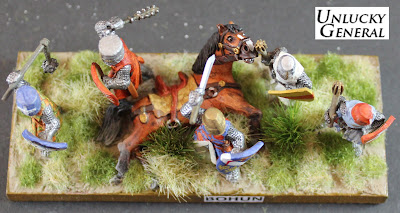Rebel Centre Ward: Knights
For the centre ward knights of my rebel army I adopted heavier lances by using a thicker gauge wire than I have used to date and gave each lance a graper which I have not done before. In comparison to previous knights in my army, these gents look far more the ticket for a mid to late thirteenth century knight. My last unit will be similarly equipped.
These figures are also from different ranges to my previous knights, coming from Crusader Miniatures 'Later Crusader' range (MCF010 and MCF012) as well as Gripping Beast 'Crusading Knights' (LCCO1 02 and 06) with some minor alterations. They are all solid sculpts and very animated and are all highly detailed which made for a demanding paint job.
They took an unusual commitment and I have definitely developed a greater attention to detail in recent years. Caparisons are all weathered and all colours (especially in the cloth) are subdued. There's quite a bit of yellow amongst the heraldry which I suppress with light brown when I mix the Humbrol enamels. I paint the maille by undercoating with a mix of Gun Metal with Gloss Black (thinned) then dry brush with Gun Metal/Aluminium mixed and thinned. I left the maille dull this time - only applying highlight of thinned Humbrol Silver on the steel helms.I'm not at all happy with the Humbrol Brass any more and will be moving to Vallejo but I still love the Humbrol Gold and Silver.
The trumpeter carries the Banner of Thomas de Hauteville (full heraldry) whom I elevated to the unit leader. The banner is made of cloth (fine cotton) cut, glued to the steel wire shaft, wrapped and dipped in a white glue solution and glued to the miniature after drying ready for the whole miniature undercoat. Of all the knight to chose as leader, I seem to have set myself the most difficult heraldry to paint. I sketched the design only after undercoating the figure. I must have been off my chops!
I gave only the leader a pennon - made of heavy foil. I've used paper pennon before and reckon cotton to be too fiddly for such a small device. I use foil for later period lance pennons and they work a treat, furl easily and effectively as well as hold their form. I recommend it. I fix them before undercoating.
This is the second unit of the army to be based on the thicker 5mm MDF bases and I've moved away from single bases of any kind. I prefer using numbered tiles to represent casualties until an equivalent element is removed. Consequently I have based this unit on two three figure bases and a command base of four figures. I'm also moving to a standard depth of 70mm to allow for charged lances and staggered, more natural alignments of the figures. The 5mm bases will also allow for labeling of the units and identifications of some of the knights and earls.








Comments